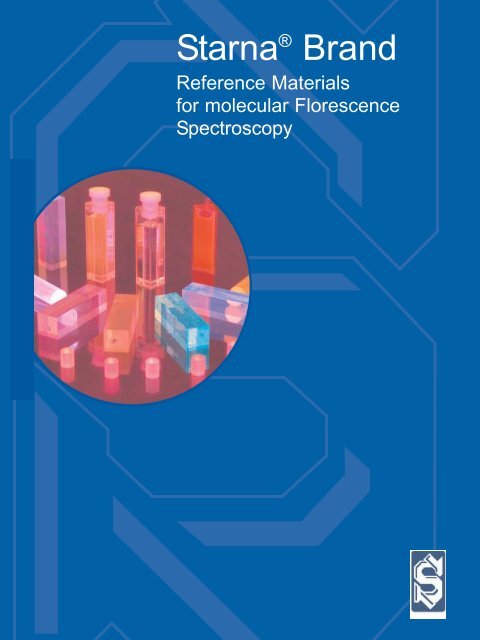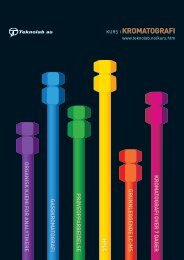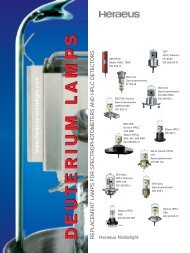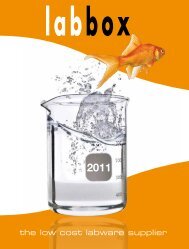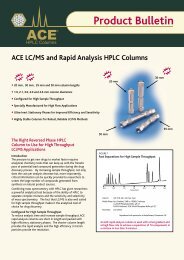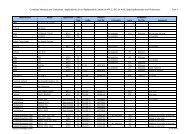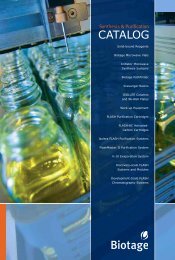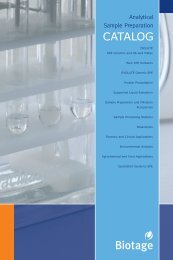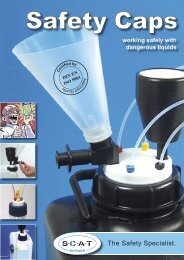Fluorescence Reference Materials Catalog - Teknolab AS
Fluorescence Reference Materials Catalog - Teknolab AS
Fluorescence Reference Materials Catalog - Teknolab AS
Create successful ePaper yourself
Turn your PDF publications into a flip-book with our unique Google optimized e-Paper software.
Starna ® Brand<br />
<strong>Reference</strong> <strong>Materials</strong><br />
for molecular Florescence<br />
Spectroscopy
<strong>Reference</strong> materials for Molecular <strong>Fluorescence</strong><br />
Spectrophotometry<br />
These materials may be used on a routine<br />
basis to calibrate and monitor the performance<br />
of <strong>Fluorescence</strong> Spectrophotometers. They<br />
are very stable and convenient to use and with<br />
reasonable treatment, will remain usable for<br />
many years. Normally the reference materials<br />
are used in a comparative mode; the<br />
instrument is adjusted to give a useful reading<br />
for a standard of known concentration, this<br />
may be directly in concentration or an arbitrary<br />
figure, eg. one corresponding to a test limit. A<br />
suitable standard is then measured under<br />
identical conditions and the intensity noted.<br />
For future assays, it is no longer necessary to<br />
prepare a standard each time the test is<br />
performed, as the reference material may<br />
simply be inserted, using the original<br />
instrument settings. Any deviation from the<br />
original reading is removed by adjusting the<br />
gain, making the instruments’ read out<br />
identical to when it was calibrated.<br />
The reference material should be selected so<br />
that there is reasonable overlap between the<br />
excitation and emission bands with that of the<br />
sample, as this will provide the best match<br />
between the readings, so that only small<br />
adjustments to the instrument gain will be<br />
needed in order to obtain suitable readings and<br />
reproducibility will be maximized.<br />
The reference materials may also be used to<br />
monitor instrument performance and for<br />
standardization. If readings for the reference<br />
material are recorded on a regular basis, using<br />
the original instrument settings, ie. before<br />
adjusting the gain to standardize the<br />
instrument, they may be used to construct a<br />
Quality Control (QC) chart. Such a chart may<br />
be used to detect variations in instrument<br />
performance, such as long term drift due to<br />
deterioration of the source or optical surfaces,<br />
also to eliminate errors that arise from any<br />
incorrect setting up or an instrument<br />
malfunction. The materials are solid, so they<br />
do not contribute any noise to the<br />
measurements caused by convection currents<br />
or striations. Multiple readings may therefore<br />
be taken and used to provide an accurate<br />
estimate of instrument precision, an important<br />
requirement for many QC situations.<br />
The fluorescent materials are dissolved in<br />
methylmethacrylate and the solution is then<br />
polymerized to produce a polymethyl<br />
methacrylate (PMMA) matrix which provides a<br />
stable environment for the fluorescent<br />
compounds. Being solids, there can be no<br />
evaporation of solvents or any significant<br />
photo-decomposition of the material, thus<br />
producing long term stability. This high<br />
stability ensures that any observed variation in<br />
readings is due to instrumental variation, rather<br />
than chemical or physical effects which may<br />
affect liquid fluorescence standards.<br />
Some advantages of solid reference materials<br />
No significant photo chemical degradation<br />
Easy to store<br />
No chemicals to mix and dilute<br />
No evaporation problems<br />
Long term stability<br />
Low overall costs<br />
1
6BF Fluorescent <strong>Reference</strong> <strong>Materials</strong> Set<br />
This consists of six polymer blocks containing seven<br />
fluorescent compounds whose spectra cover a broad<br />
spectral range with emission maxima from 330 to<br />
582nm and excitation maxima from 290 to 562 nm. This<br />
wide spectral range enables the user to select a<br />
reference material with broadly similar spectral<br />
properties to those of the analyte, ensuring a<br />
reasonable spectral overlap and measurable signals<br />
without changing important parameters such as slit<br />
widths and wavlength settings.<br />
Each block is produced with optically polished surfaces<br />
on six sides, with dimensions of 12.5 x 12.5 x 45mm to<br />
fit the standard cell holders used in spectrofluorimeters.<br />
Starna is able to produce these materials in other sizes<br />
and shapes such as rods, cylinders and discs to fit other<br />
instruments and will quote for such requirements.<br />
Certain other materials can also be produced in similar<br />
form for specific studies such as phosphorescence, or<br />
singlet and triplet life time measurements and enquiries<br />
are welcome.<br />
<strong>Fluorescence</strong> Spectra<br />
<strong>Fluorescence</strong> spectra are not absolute in the sense<br />
that absorption spectra are and the appearance of the<br />
spectra will depend upon the particular instrument and<br />
the mode used to record it. Most modern instruments<br />
have a choice of operating mode and this needs to be<br />
selected according to the analytical requirement.<br />
Direct measurement of fluorescent intensity produces<br />
very distorted spectra. The effects of the varying<br />
intensity of the source, which falls off considerably with<br />
decreasing wavelength, the sensitivity of the detector<br />
which normally has a maximum in the near UV region<br />
and the light throughput of the monochromators which<br />
generally have a maximum in the UV region and<br />
whose efficiency falls off rapidly at shorter wavelengths<br />
and more gradually at longer wavelengths, are not<br />
compensated for. The advantage of this mode is that as<br />
the minimum number of optical components are used<br />
and no signal processing is required, it can produce the<br />
highest sensitivity for quantitative analysis, providing<br />
that the spectra are simple and the bands of interest are<br />
well resolved.<br />
The Ratio Mode allows the instrument to monitor<br />
the intensity of the excitation source by means of a<br />
reference photomultiplier and presents the output in<br />
terms of a ratio to this reference signal, thus freeing<br />
the recorded spectrum of effects due to the varying<br />
energy of the source. This produces a good signal to<br />
noise ratio and therefore high sensitivity, as well as<br />
monitoring and correcting for drift. For quantitative<br />
analysis, it is usually the mode of choice, particularly for<br />
samples which produce more complex spectra.<br />
The Corrected Spectra Mode produces a spectrum in<br />
which many of the above effects are compensated for,<br />
usually by spectral manipulation with a computer,<br />
although some older instruments may still use electooptical<br />
methods to achieve the adjustments. This mode<br />
produces an excitation spectrum which has similar<br />
characteristics to that of the UV-Visible absorption<br />
spectrum. The sensitivity of the fluorescence spectra is<br />
much higher than that of the absorption spectrum, but<br />
direct comparisons can still be made, as the shapes are<br />
similar. It is also possible to make quantum yield<br />
measurements and energy yield calculations from<br />
the corrected spectra. This feature may be ofassistance<br />
if the instrument is being used to assist with the<br />
identification of the analyte, as these properties are<br />
known for a large number of substances. This mode<br />
also permits the comparison of data from different<br />
instruments which should show similar wavelengths for<br />
excitation maxima and minima, as well as similar values<br />
for ratios of the intensity of different bands and similar<br />
shapes for the spectral bands. Such spectra are<br />
particularly useful for publication and inter-laboratory<br />
studies, as uncorrected spectra, even those run on<br />
similar types of instrument, will include the various<br />
distortions introduced by the particular apparatus.<br />
Wavelength Calibration<br />
The spectra of the materials provided in this set of<br />
reference materials are well established and their<br />
maxima and minima may be used to check the<br />
wavelength calibration of instruments which operate with<br />
narrow spectral band widths. <strong>Materials</strong> which<br />
produce narrow bands, such as anthracene and<br />
ovalene are particularly suitable for this application.<br />
However, it is important to ensure that such calibrations<br />
are carried out in the corrected mode at small spectral<br />
bandwidths, or errors can be introduced by peak<br />
broadening or apparent wavelength shifts due to<br />
instrumental effects.<br />
The illustrated spectra were obtained using a Perkin<br />
Elmer LS50B spectrofluorimeter and the spectral band<br />
widths 2.5nm for all spectra. These spectra are for<br />
guidance only and will vary in shape if different spectral<br />
band widths are used. The peak wave lengths are only<br />
comparable for instruments operating in the corrected<br />
spectra mode. If this mode is not available, it is<br />
important that all instrument settings are reproduced<br />
exactly on each occasion, in order to ensure that<br />
subsequent comparisons are valid.<br />
Selectivity<br />
Molecular <strong>Fluorescence</strong> Spectrometry is a more<br />
selective technique than UV-Visible Spectrophotometry.<br />
Material No.1 contains a mixture of Anthracene and<br />
Naphthalene and may be used to demonstrate the<br />
greater selectivity of the fluorescence technique. By<br />
exciting at two different wave lengths, the emission<br />
spectrum of either substance can be obtained free of<br />
interference from the other.<br />
2
The Fluorescent <strong>Materials</strong><br />
Sample Compound Approximate Excitation Emission<br />
Number Molar Conc. Wavelength Wavelength<br />
1 Anthracene 1 x 10 -5 360 402<br />
Napthalene 6 x 10 -5 290 330<br />
2 Ovalene 2 x 10 -7 342 482<br />
3 p -Terphenyl 5 x 10 -7 295 338<br />
4 Tetraphenylbutadiene 3 x 10 -7 348 422<br />
5 Compound 610 1 x 10 -6 440 475<br />
6 Rhodamine 2 x 10 -7 562 573<br />
Care of the <strong>Reference</strong> <strong>Materials</strong><br />
The blocks are supplied in a velvet lined case to<br />
protect the fine surface finish produced at manufacture.<br />
Providing that they are handled with care (cotton gloves<br />
are recommended) and always stored in the case<br />
provided, they should give many years of satisfactory<br />
service. Exposure to organic solvents can cause severe<br />
fogging of the surface and must be avoided, as should<br />
any attempt to clean the block with abrasive cleaners.<br />
In the event of the surface of a block becoming soiled, it<br />
should be immersed in dilute neutral detergent solution<br />
which may be warmed to 40°. Low power ultrasonic<br />
vibration may also be used to remove the contamination.<br />
It should then be rinsed thoroughly with deionized water<br />
and dried carefully with a soft lint-free cloth.<br />
Recorded Spectra<br />
The following spectra were recorded in the ratio<br />
mode, using a Perkin Elmer LS50B Luminescence<br />
Spectrometer. The spectral band width for both<br />
excitation and emission monochromators, was 2.5 nm.<br />
Data points were recorded at 0.5 nm intervals. These<br />
spectra are specific to this instrument and the operating<br />
conditions used. Other instruments, or different<br />
operating conditions will produce spectra with maxima<br />
which may vary both in terms of relative magnitude and<br />
wavelength.<br />
The corrected Spectra were recorded using a Perkin<br />
Elmer MPF44-B and should relate to others recorded in<br />
a similar manner.<br />
3
400<br />
<strong>Reference</strong> material No. 1 Anthracene<br />
300<br />
Excitation Intensity<br />
Emission Intensity<br />
Concentration: 1 x 10E-5 M<br />
Excitation: 360nm<br />
Emission: 402nm<br />
200<br />
View Corrected Spectra<br />
100<br />
0<br />
280 300 320 340 360 380 400 420 440 460 480<br />
Wavelength nm<br />
120<br />
<strong>Reference</strong> material No. 1 Napthalene<br />
100<br />
Excitation Intensity<br />
Emission Intensity<br />
80<br />
Concentration: 6 x 10-5E M<br />
Excitation: 290 nm<br />
Emission: 330 nm<br />
View Corrected Spectra<br />
60<br />
40<br />
20<br />
0<br />
240 250 260 270 280 290 300 310 320 330 340 350 360 370 380 390 400 410<br />
Wavelength nm<br />
4
400<br />
<strong>Reference</strong> Material No 2 - Ovalene<br />
<strong>Reference</strong> material No. 2 Ovalene<br />
Excitation Intensity<br />
Emission Intensity<br />
300<br />
Concentration: 2x10E-7 M<br />
Excitation: 342 nm<br />
Emission: 482 nm<br />
View Corrected Spectra<br />
200<br />
100<br />
0<br />
280 300 320 340 360 380 400 420 440 460 480 500 520 540 560 580 600<br />
Wavelength nm<br />
120<br />
<strong>Reference</strong> material No. 3 p-Terphenyl<br />
110<br />
100<br />
90<br />
80<br />
70<br />
Excitation: 295nm<br />
Emission : 338nm<br />
SBW: 5 nm<br />
Excitation Intensity<br />
Emission Intensity<br />
View Corrected Spectra<br />
60<br />
50<br />
40<br />
30<br />
20<br />
10<br />
0<br />
240 260 280 300 320 340 360 380 400 420<br />
Wavelength nm<br />
5
90<br />
<strong>Reference</strong> material No. 4 Tetraphenylbutadiene<br />
80<br />
Excitation Intensity<br />
70<br />
Emission Intensity<br />
60<br />
Concentration: 3x10E-7 M<br />
Excitation: 348 nm<br />
Emission: 422 nm<br />
50<br />
View Corrected Spectra<br />
40<br />
30<br />
20<br />
10<br />
0<br />
280 300 320 340 360 380 400 420 440 460 480 500 520 540 560 580<br />
Wavelength nm<br />
100<br />
<strong>Reference</strong> material No. 5 Compound 610<br />
Excitation Intensity<br />
Emission Intensity<br />
80<br />
Concentration: 1x10E-6 M<br />
Excitation: 440 nm<br />
Emission: 480 nm<br />
View Corrected Spectra<br />
60<br />
40<br />
20<br />
0<br />
400 420 440 460 480 500 520 540<br />
Wavelength nm<br />
6
140<br />
<strong>Reference</strong> material No. 6 Rhodamine B<br />
130<br />
120<br />
110<br />
100<br />
90<br />
Concentration: 2x10E-7 M<br />
Excitation: 562 nm<br />
Emission: 573 nm<br />
Excitation Intensity<br />
Emission Intensity<br />
View Corrected Spectra<br />
80<br />
70<br />
60<br />
50<br />
40<br />
30<br />
20<br />
10<br />
0<br />
500 550 600<br />
Wavelength nm<br />
7
120<br />
<strong>Reference</strong> material No. 1 Anthracene - Corrected Spectra<br />
100<br />
Excitation Intensity<br />
Emission Intensity<br />
80<br />
Excitation: 360nm<br />
Emission: 402nm<br />
SBW: 5nm<br />
Back<br />
60<br />
40<br />
20<br />
0<br />
300 310 320 330 340 350 360 370 380 390 400 410 420 430 440 450 460 470<br />
Wavelength nm<br />
120<br />
<strong>Reference</strong> material No. 1 Napthalene - Corrected Spectra<br />
110<br />
100<br />
90<br />
Excitation Intensity<br />
Emission Intensity<br />
80<br />
70<br />
Excitation: 280nm<br />
Emission: 330nm<br />
SBW: 5nm<br />
Back<br />
60<br />
50<br />
40<br />
30<br />
20<br />
10<br />
0<br />
240 250 260 270 280 290 300 310 320 330 340 350 360 370 380 390 400 410<br />
Wavelength nm<br />
8
120<br />
<strong>Reference</strong> material No. 2 Ovalene - Corrected Spectra<br />
110<br />
100<br />
90<br />
80<br />
Excitation: 342 nm<br />
Emission: 482 nm<br />
SBW: 5 nm<br />
Back<br />
Excitation Intensity<br />
Emission Intensity<br />
70<br />
60<br />
50<br />
40<br />
30<br />
20<br />
10<br />
0<br />
280 300 320 340 360 380 400 420 440 460 480 500 520 540 560 580<br />
Wavelength nm<br />
120<br />
<strong>Reference</strong> material No. 3 p-Terphenyl - Corrected Spectra<br />
110<br />
100<br />
90<br />
80<br />
70<br />
Excitation: 295nm<br />
Emission : 338nm<br />
SBW: 5 nm<br />
Back<br />
Excitation Intensity<br />
Emission Intensity<br />
60<br />
50<br />
40<br />
30<br />
20<br />
10<br />
0<br />
240 260 280 300 320 340 360 380 400 420<br />
Wavelength nm<br />
9
120<br />
<strong>Reference</strong> material No. 4 Tetraphenylbutadiene - Corrected Spectra<br />
110<br />
100<br />
Excitation Intensity<br />
Emission Intensity<br />
90<br />
80<br />
Excitation: 348nm<br />
Emission: 422nm<br />
SBW: 5nm<br />
Back<br />
70<br />
60<br />
50<br />
40<br />
30<br />
20<br />
10<br />
0<br />
260 280 300 320 340 360 380 400 420 440 460 480 500 520 540 560<br />
Wavelength nm<br />
<strong>Reference</strong> material No. 5 Compound 610 - Corrected Spectra<br />
Back<br />
Wavelength nm<br />
10
120<br />
<strong>Reference</strong> material No. 6 Rhodamine B - Corrected Spectra<br />
Excitation Intensity<br />
100<br />
80<br />
Excitation: 562nm<br />
Emission: 573nm<br />
SBW: 5nm<br />
Emission Intensity<br />
Intensity<br />
60<br />
40<br />
20<br />
0<br />
500 510 520 530 540 550 560 570 580 590 600 610<br />
Wavelength nm<br />
Order information for Fluorescent reference materials<br />
6BF Set of six reference materials for Fluorescent spectrophotometry<br />
Polymethylmethacrylate blocks containing seven materials with excitation maxima between<br />
290 and 562nm emission between 330 and 573nm, packaged in a velvet lined case.<br />
11
Optiglass Limited<br />
52-54 Fowler Road, Hainault,<br />
Essex IG6 3UT, UK.<br />
Produced in the UK by Alastair Clark Associates<br />
Starna ® Brand<br />
Sales & Technical Assistance<br />
Tel: +44 (0)20 8501 5550<br />
Fax: +44 (0)20 8501 1118<br />
Email: starnabrand@optiglass.co.uk<br />
Starna ® Cells Inc.<br />
PO Box 1919<br />
Atascadero<br />
CA 93423<br />
USA<br />
Tel: (800) 228 4482<br />
(805) 466 8855<br />
Fax: (805) 461 1575<br />
Email: info@starna.com<br />
Starna ® Pty.<br />
PO Box 113<br />
Thornleigh<br />
NSW 2120<br />
AUSTRALIA<br />
Tel: 1 800 252 284<br />
(02) 9484 0033<br />
Fax: (02) 9484 0055<br />
Email: info@starna.com.au<br />
Starna ® GmbH<br />
Postfach 1206<br />
D-64311 Pfungstadt<br />
GERMANY<br />
Tel: (06157) 2813<br />
Fax: (06157) 85564<br />
Email: starna@t-online.de<br />
Starna ® GesmbH<br />
Oberneuberg 78<br />
A-8225 Poellauberg<br />
AUSTRIA<br />
Tel: (03335) 4850<br />
Fax: (03335) 4851<br />
Email: starna-austria@netway.at<br />
All rights reserved. No part of this publication may be reproduced, stored in a retrieval system, or transmitted, in any form or by any means,<br />
electronic, mechanical, photocopying, recording or otherwise, without the prior permission of Optiglass Ltd.


